Technology, Teamwork Come Together at Olsen Hall’s New TEAL Classrooms
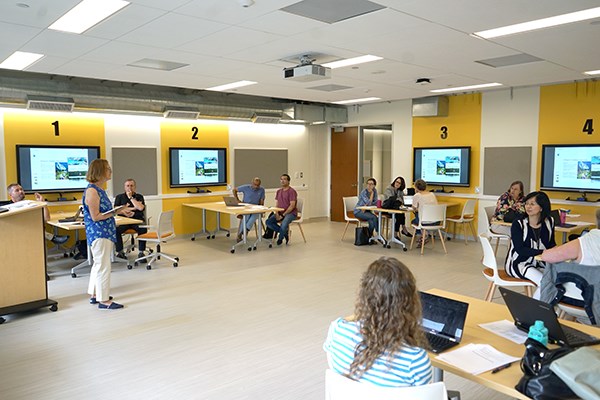 Image by Ed Brennen
Image by Ed Brennen
08/29/2019
By Ed Brennen
Two classrooms in Olsen Hall are sporting a different look this fall, one that represents a significant step forward in team-based active learning at the university.
Inside the new Technology Enhanced Active Learning (TEAL) classrooms on the renovated third floor of Olsen Hall, there are no desks facing a professor’s podium at the front of the room. Instead, the rooms are equipped with tables for six (referred to as “pods”) along the room’s perimeter, each centered around a 55-inch touchscreen monitor. Students wirelessly connect their laptops, tablets or phones to their group’s pod to collaborate on work.
And instead of standing at a lectern, the professor is free to roam around the room with an iPad that syncs to their own 75-inch interactive monitor. All of the pods in the classroom connect to the professor’s centralized interface, allowing for a seamless exchange of work and feedback.
Equipped with Sony’s new Vision Exchange technology platform, the TEAL classrooms — one for 64 students and the other for 36 students — are expected to open the door to increased collaboration and group work and promote more class participation.
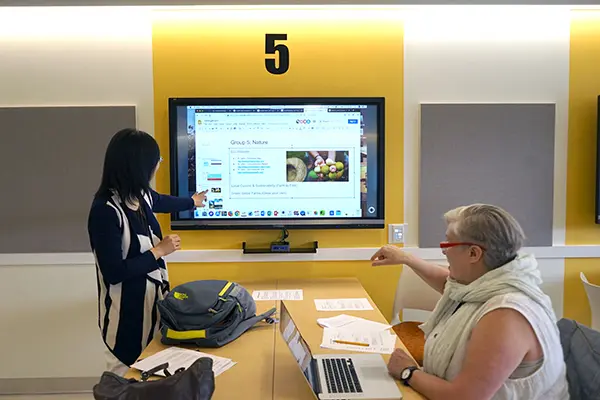 Image by Ed Brennen
Image by Ed Brennen
And UMass Lowell is pioneering this move, becoming one of the first universities in the Northeast to equip classrooms with the immersive technology.
“We’re really excited about it, and we hope faculty are too,” says Senior Director of Information Technology Services and Instructional Technology Support Mike Lucas, who helped select the Sony platform earlier this year as a member of the Academic Technology Committee. “When we saw it, it stood out from the crowd. It shocked us with its simplicity.”
Nearly two dozen faculty members are teaching 30 courses — everything from accounting and biology to English and physics — in the Olsen classrooms this fall. A third TEAL classroom (for 36 students) will open in the spring at the renovated Coburn Hall on South Campus.
Asst. Prof. of Biology Frederic Chain is teaching bioinformatics (the science of collecting and analyzing complex biological data such as genetic codes) in a TEAL classroom at Olsen this semester. He says it’s “an exciting opportunity” to improve learning outcomes by increasing student participation and engagement.
“It will allow students to share within and across pods their solutions to problem sets,” Chain says. “I anticipate it being particularly powerful for sharing code and database navigation strategies, as each student’s computer can be linked to the monitors across pods.”
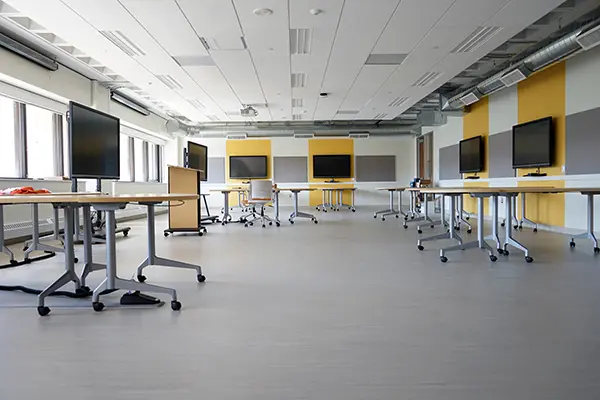 Image by Ed Brennen
Image by Ed Brennen
Just as professors have to rethink their curriculum when adopting a flipped classroom model, teaching in a TEAL classroom requires faculty to incorporate active learning strategies into their coursework. That’s why the Transformational Education Committee earlier this year awarded $1,000 mini-grants to 12 faculty members to develop teaching strategies for TEAL classrooms.
Clinical Assoc. Prof. Michelle Scribner-MacLean, educational technology coordinator for the College of Education, is helping faculty understand how to improve teaching and learning in the new classrooms through her role as the university’s TEAL fellow.
“With these pods, students are able to go deeper into the content and explore more, and then share with each other,” says Scribner-MacLean, who led a TEAL workshop for mini-grant recipients in May at O’Leary Library, where they were able to try out the technology for the first time in the Faculty Sandbox.
“Give them questions that are messy and let them figure it out if they can. Having them roll up their sleeves and do the work is where the learning happens,” Scribner-MacLean told faculty, whom she said should think of themselves as a coach rather than a “sage on the stage” in active learning environments.
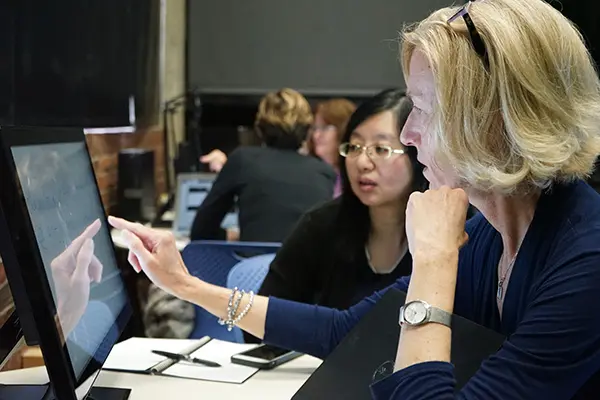 Image by Ed Brennen
Image by Ed Brennen
Asst. Teaching Prof. Lisa Andrusaitis is teaching two sections of financial accounting this semester — one in a TEAL classroom and one in a traditional classroom.
“It will be interesting to see the difference between the two classes,” says Andrusaitis, who anticipates the workgroup-based environment of the TEAL classroom will make students more willing to contribute.
“Accounting is a difficult subject,” she says. “But I think students will gravitate toward this type of technology. And that alone might help them learn the material better.”
Jennifer Cadero-Gillette, an assistant teaching professor in the Art & Design Department, will teach “Art History Survey: Renaissance to Modern” in Coburn’s new TEAL classroom in the spring. She plans to have student teams research and analyze objects “within their specific historical and socio-cultural contexts” and then “curate” their selected objects into a classwide digital exhibition.
“This is a game-changer for my field,” says Cadero-Gillette, who envisions “tapping into the TEAL classroom by creating a ‘Hybrid Art History Survey’ that incorporates hands-on, student-initiated inquiry and engagement with the material.”
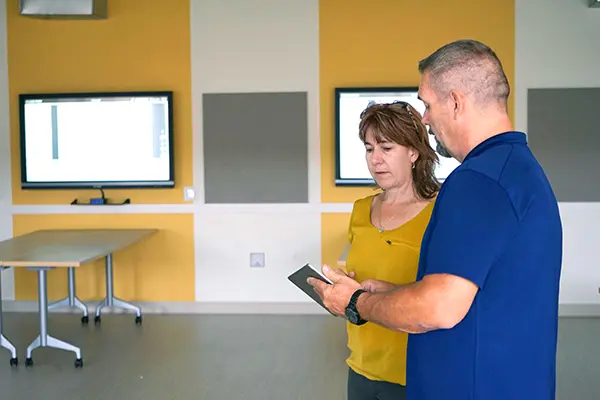 Image by Ed Brennen
Image by Ed Brennen
In addition to offering training sessions over the summer, Manager of IT Services Robert Coppenrath, Instructional Technologist Randy Tyndall and Lucas will provide in-class support during the semester’s opening week.
“The technology is the easy part,” Coppenrath says. “Seeing how it will be applied in the classroom is the interesting part.”
While the giant touchscreens and wireless workflow will garner a lot of attention, the TEAL classrooms are about more than just technology, according to Executive Director of Planning, Design and Construction Adam Baacke.
“It’s about having students work in teams on active, engaged projects,” says Baacke, who notes that more TEAL classrooms could be added to the campus plan in the future. “Faculty have been teaching in this mode for some time, but now we have the chance to create spaces with the furnishing and technology where they can really flourish.”



